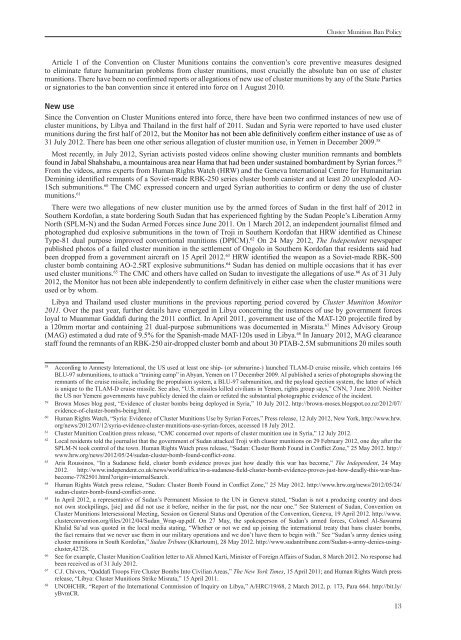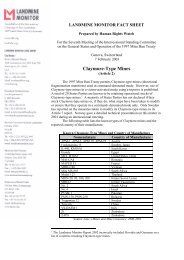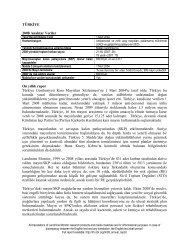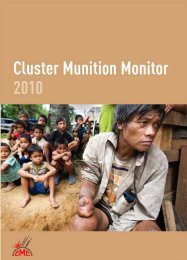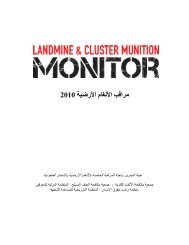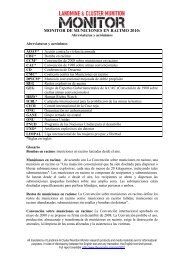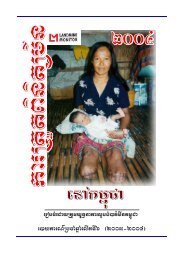Download PDF - Landmine and Cluster Munition Monitor
Download PDF - Landmine and Cluster Munition Monitor
Download PDF - Landmine and Cluster Munition Monitor
Create successful ePaper yourself
Turn your PDF publications into a flip-book with our unique Google optimized e-Paper software.
<strong>Cluster</strong> <strong>Munition</strong> Ban Policy<br />
Article 1 of the Convention on <strong>Cluster</strong> <strong>Munition</strong>s contains the convention’s core preventive measures designed<br />
to eliminate future humanitarian problems from cluster munitions, most crucially the absolute ban on use of cluster<br />
munitions. There have been no confirmed reports or allegations of new use of cluster munitions by any of the State Parties<br />
or signatories to the ban convention since it entered into force on 1 August 2010.<br />
New use<br />
Since the Convention on <strong>Cluster</strong> <strong>Munition</strong>s entered into force, there have been two confirmed instances of new use of<br />
cluster munitions, by Libya <strong>and</strong> Thail<strong>and</strong> in the first half of 2011. Sudan <strong>and</strong> Syria were reported to have used cluster<br />
munitions during the first half of 2012, but the <strong>Monitor</strong> has not been able definitively confirm either instance of use as of<br />
31 July 2012. There has been one other serious allegation of cluster munition use, in Yemen in December 2009. 58<br />
Most recently, in July 2012, Syrian activists posted videos online showing cluster munition remnants <strong>and</strong> bomblets<br />
found in Jabal Shahshabu, a mountainous area near Hama that had been under sustained bombardment by Syrian forces. 59<br />
From the videos, arms experts from Human Rights Watch (HRW) <strong>and</strong> the Geneva International Centre for Humanitarian<br />
Demining identified remnants of a Soviet-made RBK-250 series cluster bomb canister <strong>and</strong> at least 20 unexploded AO-<br />
1Sch submunitions. 60 The CMC expressed concern <strong>and</strong> urged Syrian authorities to confirm or deny the use of cluster<br />
munitions. 61<br />
There were two allegations of new cluster munition use by the armed forces of Sudan in the first half of 2012 in<br />
Southern Kordofan, a state bordering South Sudan that has experienced fighting by the Sudan People’s Liberation Army<br />
North (SPLM-N) <strong>and</strong> the Sudan Armed Forces since June 2011. On 1 March 2012, an independent journalist filmed <strong>and</strong><br />
photographed dud explosive submunitions in the town of Troji in Southern Kordofan that HRW identified as Chinese<br />
Type-81 dual purpose improved conventional munitions (DPICM). 62 On 24 May 2012, The Independent newspaper<br />
published photos of a failed cluster munition in the settlement of Ongolo in Southern Kordofan that residents said had<br />
been dropped from a government aircraft on 15 April 2012. 63 HRW identified the weapon as a Soviet-made RBK-500<br />
cluster bomb containing AO-2.5RT explosive submunitions. 64 Sudan has denied on multiple occasions that it has ever<br />
used cluster munitions. 65 The CMC <strong>and</strong> others have called on Sudan to investigate the allegations of use. 66 As of 31 July<br />
2012, the <strong>Monitor</strong> has not been able independently to confirm definitively in either case when the cluster munitions were<br />
used or by whom.<br />
Libya <strong>and</strong> Thail<strong>and</strong> used cluster munitions in the previous reporting period covered by <strong>Cluster</strong> <strong>Munition</strong> <strong>Monitor</strong><br />
2011. Over the past year, further details have emerged in Libya concerning the instances of use by government forces<br />
loyal to Muammar Gaddafi during the 2011 conflict. In April 2011, government use of the MAT-120 projectile fired by<br />
a 120mm mortar <strong>and</strong> containing 21 dual-purpose submunitions was documented in Misrata. 67 Mines Advisory Group<br />
(MAG) estimated a dud rate of 9.5% for the Spanish-made MAT-120s used in Libya. 68 In January 2012, MAG clearance<br />
staff found the remnants of an RBK-250 air-dropped cluster bomb <strong>and</strong> about 30 PTAB-2.5M submunitions 20 miles south<br />
58<br />
According to Amnesty International, the US used at least one ship- (or submarine-) launched TLAM-D cruise missile, which contains 166<br />
BLU-97 submunitions, to attack a “training camp” in Abyan, Yemen on 17 December 2009. AI published a series of photographs showing the<br />
remnants of the cruise missile, including the propulsion system, a BLU-97 submunition, <strong>and</strong> the payload ejection system, the latter of which<br />
is unique to the TLAM-D cruise missile. See also, “U.S. missiles killed civilians in Yemen, rights group says,” CNN, 7 June 2010. Neither<br />
the US nor Yemeni governments have publicly denied the claim or refuted the substantial photographic evidence of the incident.<br />
59<br />
Brown Moses blog post, “Evidence of cluster bombs being deployed in Syria,” 10 July 2012. http://brown-moses.blogspot.co.nz/2012/07/<br />
evidence-of-cluster-bombs-being.html.<br />
60<br />
Human Rights Watch, “Syria: Evidence of <strong>Cluster</strong> <strong>Munition</strong>s Use by Syrian Forces,” Press release, 12 July 2012, New York, http://www.hrw.<br />
org/news/2012/07/12/syria-evidence-cluster-munitions-use-syrian-forces, accessed 18 July 2012.<br />
61<br />
<strong>Cluster</strong> <strong>Munition</strong> Coalition press release, “CMC concerned over reports of cluster munition use in Syria,” 12 July 2012.<br />
62<br />
Local residents told the journalist that the government of Sudan attacked Troji with cluster munitions on 29 February 2012, one day after the<br />
SPLM-N took control of the town. Human Rights Watch press release, “Sudan: <strong>Cluster</strong> Bomb Found in Conflict Zone,” 25 May 2012. http://<br />
www.hrw.org/news/2012/05/24/sudan-cluster-bomb-found-conflict-zone.<br />
63<br />
Aris Roussinos, “In a Sudanese field, cluster bomb evidence proves just how deadly this war has become,” The Independent, 24 May<br />
2012. http://www.independent.co.uk/news/world/africa/in-a-sudanese-field-cluster-bomb-evidence-proves-just-how-deadly-this-war-hasbecome-7782501.htmlorigin=internalSearch.<br />
64<br />
Human Rights Watch press release, “Sudan: <strong>Cluster</strong> Bomb Found in Conflict Zone,” 25 May 2012. http://www.hrw.org/news/2012/05/24/<br />
sudan-cluster-bomb-found-conflict-zone.<br />
65<br />
In April 2012, a representative of Sudan’s Permanent Mission to the UN in Geneva stated, “Sudan is not a producing country <strong>and</strong> does<br />
not own stockpilings, [sic] <strong>and</strong> did not use it before, neither in the far past, nor the near one.” See Statement of Sudan, Convention on<br />
<strong>Cluster</strong> <strong>Munition</strong>s Intersessional Meeting, Session on General Status <strong>and</strong> Operation of the Convention, Geneva, 19 April 2012. http://www.<br />
clusterconvention.org/files/2012/04/Sudan_Wrap-up.pdf. On 27 May, the spokesperson of Sudan’s armed forces, Colonel Al-Sawarmi<br />
Khalid Sa’ad was quoted in the local media stating, “Whether or not we end up joining the international treaty that bans cluster bombs,<br />
the fact remains that we never use them in our military operations <strong>and</strong> we don’t have them to begin with.” See “Sudan’s army denies using<br />
cluster munitions in South Kordofan,” Sudan Tribune (Khartoum), 28 May 2012. http://www.sudantribune.com/Sudan-s-army-denies-usingcluster,42728.<br />
66<br />
See for example, <strong>Cluster</strong> <strong>Munition</strong> Coalition letter to Ali Ahmed Karti, Minister of Foreign Affairs of Sudan, 8 March 2012. No response had<br />
been received as of 31 July 2012.<br />
67<br />
C.J. Chivers, “Qaddafi Troops Fire <strong>Cluster</strong> Bombs Into Civilian Areas,” The New York Times, 15 April 2011; <strong>and</strong> Human Rights Watch press<br />
release, “Libya: <strong>Cluster</strong> <strong>Munition</strong>s Strike Misrata,” 15 April 2011.<br />
68<br />
UNOHCHR, “Report of the International Commission of Inquiry on Libya,” A/HRC/19/68, 2 March 2012, p. 173, Para 664. http://bit.ly/<br />
yBvmCR.<br />
13


